IMS2019 returned to Boston in its normal 10 year rotation through major centers of microwave activity. The theme was the Hub of Microwaves as Boston is laid out in a spoke and hub highway formation around the city to access the suburbs where many microwave companies reside. The event took place from June 2 to 7 at the Boston Convention and Exhibition Center (BCEC) and featured the Radio Frequency Integrated Circuit (RFIC) Symposium, the International Microwave Symposium (IMS), the 5G Summit and the ARFTG Microwave Measurements Conference. The social and networking events took place throughout the revitalized Seaport District in Boston. This neighborhood, adjacent to the BCEC, has undergone a remarkable transformation since the 2009 IMS, and is now home to many museums, shops, restaurants and nightlife. The 2019 International Microwave Week will be memorable for years to come.
Videos and photos from the event can be found here:
IMS2019 Videos
IMS2019 Photo Gallery
Boston has a rich microwave heritage that continues through today. The Radiation Laboratory, run by the Massachusetts Institute of Technology (MIT) during the 1940s, made seminal contributions to the emerging microwave engineering field. Much of this knowledge was transferred to surrounding industry and universities in the 1950s. The local IMS Steering Committees took particular pride in balancing the traditions of IMS with innovative twists and a focus on creating the best experience for the technical and industry exhibition attendees.
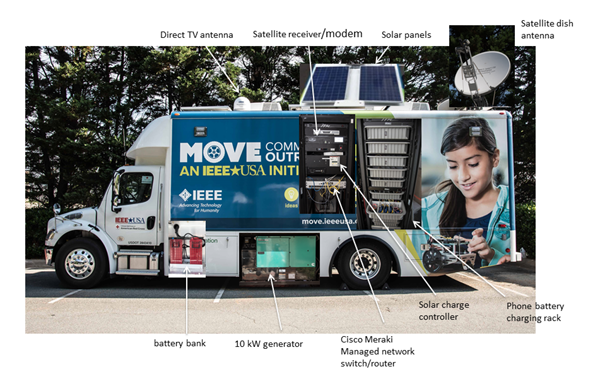
Putting a name with a face, we had the opportunity to talk with Jay Diepenbrock, SiRF Technology Consultant, who was at IMS representing IEEE’s MOVE truck. Tucked in the far right corner of the show floor, but has had a phenomenal impact in rescue operations was IEEE’s MOVE truck. MOVE (MObile VEhicle ) is an IEEE Project that creates and operates a vehicle for disaster relief providing needed communications, light and power to victims. This Mobile Outreach Vehicle operates with a group of IEEE member volunteers to provide disaster relief. The volunteers bring a wide range of experience and use their unique skills along with demonstrating their technologies that are used in the industry to help people during disaster relief. Jay Diepenbrock provided the tour and was passionate about the cause explaining how the vehicle has actively been involved in responding to disaster survivors who have survived the initial catastrophe. "Unlike other First Responder Efforts (e.g., ARRL, RACES), this project is intended to help the disaster survivors by supplying valuable services until normal infrastructure is restored," said Jay Diepenbrock. Additionally it energizes the IEEE volunteer base, highlights skills, promotes public awareness and more. For more information and detailing regarding the truck, visit https://www.signalintegrityjournal.com/articles/782-the-ieee-move-truck.
The IMS2019 Exhibition consisted of over 600 exhibiting companies who represent the state-of-the-art when it comes to materials, devices, components and subsystems, as well as design and simulation software and test & measurement equipment. It is the best place to find out about new products and services being offered in the RF/microwave industry. It is also the best place to network with industry experts to find out answers to your design, simulation and test & measurement challenges.
The Exhibition also included the MicroApps and Exhibitor Workshops addressing new products, processes and applications of interest to the microwave community. There was more than 65 15-minute presentations given by representatives of companies from around the world as part of the MicroApps program. The Industry Workshops were two-hours each in duration, with one or more presentations. They are awarded to a single company or group of companies to discuss a specific technical topic in much greater depth than the MicroApps seminars, possibly with live demonstrations and attendee participation. Here is a summary of the products and services we saw on display this year in the exhibition:
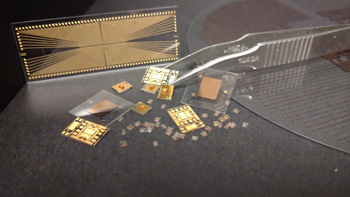 3D Glass Solutions displayed their passive component products including: Antennas, Baluns, Filters, Inductors, Capacitors, Couplers, etc., all integral to the efficiency of RF circuits and designs. 3D Glass Solutions’ circuit elements allow circuit designers to integrate multiple dielectric constants, including air. The ability to design with air allows very high performance at high frequencies (>1GHz) which are necessary for Mil Aero and Commercial RF applications (5G, Autonomous Vehicle, High Speed Data Photonics). Traditional technologies fall short of needed performance at high frequencies.
3D Glass Solutions displayed their passive component products including: Antennas, Baluns, Filters, Inductors, Capacitors, Couplers, etc., all integral to the efficiency of RF circuits and designs. 3D Glass Solutions’ circuit elements allow circuit designers to integrate multiple dielectric constants, including air. The ability to design with air allows very high performance at high frequencies (>1GHz) which are necessary for Mil Aero and Commercial RF applications (5G, Autonomous Vehicle, High Speed Data Photonics). Traditional technologies fall short of needed performance at high frequencies.
3D Glass Solutions’ technology is based on using ‘glass-ceramic’ substrate materials which are manufactured (IP) with a process similar to conventional semiconductor fabrication methods. Markets include Mil-Aero, Commercial Telecom, High Speed Data, Automotive Radar, etc. Customers are typically component and system designers working in high frequency, power conversion, Radar, antennas or RF system integration.
Advanced Microwave Technology (AMT) – Booth #283
AMT is a leading company in the research, development, design, manufacture and distribution of RF, Microwave and Millimeter-wave 50 Ω coaxial cables, connectors, adapters, cable assemblies and passive devices up to 110 GHz. With 10 years rapid development, more than 200 types of cables are available. Special products include phase stable cables with out-meter covers from mini 1.2mm to 12mm enduring high power and ultra stable phase cables whose phase vs temperature is 100 ppm @ -10℃~+55℃.
AGC Nelco highlighted the following materials:
N9000 PTFE laminates provide superior mechanical and electrical performance for your lowest electrical loss and high frequency applications. N9000 materials provide tightly controlled dielectric constant, loss and thickness, passive intermodulation (PIM) performance up to 25% better, and foil adhesion 50-100% greater than other PTFE laminates available.
Nelco Meteorwave materials offer very advanced electrical performance and very high reliability. They are intended for use in next generation applications where low signal attenuation, high reliability and high data transfer rates are critical. Meteorwave products are designed to facilitate high temperature lead-free assemblies and high layer count printed circuit board designs that require high reliability, CAF resistance and low Z-axis expansion. Meteorwave materials are also available with controlled Dk’s of 3.5 and a new Dk 3.0 material. M-Ply is a Meteorwave-based bond ply for RF hybrid applications.
The management team from fabless MMIC start-up Altum RF was introducing the company and its capabilities to prospective customers at IMS. Altum RF plans to fill the product gaps left by the consolidation of RF semiconductor players and address emerging market opportunities, particularly mmWave systems. The strategy of the highly experienced management team is to recruit design talent around the globe and use whichever foundry process is best suited for the design. To demonstrate the company’s capabilities, VP of engineering Tony Fattorini gave a MicroApps presentation discussing the company’s design philosophy: appropriate technology selection (e.g., GaAs, GaN) with unified modeling of the electrical, electromagnetic and thermal characteristics of the device to achieve superior performance.
AMCAD Engineering was featuring their IQStar 50 ohm characterization system that generates interactive datasheets. They had an NI test setup to characterize device parameters and the system will automatically make all of the measurements over various frequencies and conditions; then automatically generate an interactive datasheet. Users can then see the device performance under various conditions to see if it fits their needs using the interactive datasheet program. This really seems to be the future in device characterization and display to the customer.
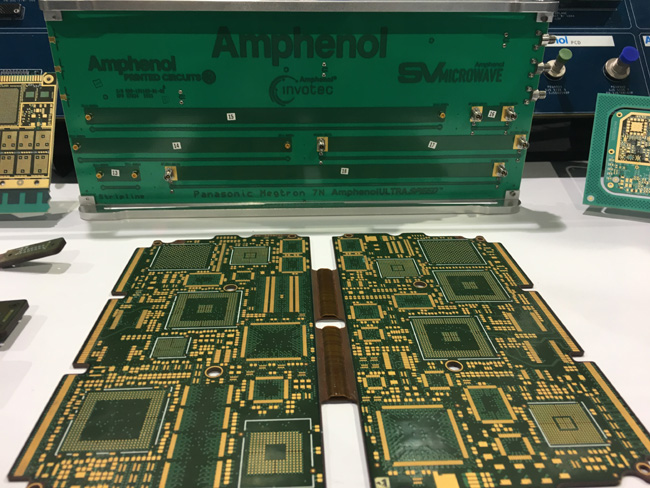 Amphenol and SV Microwave were showing their jointly developed Megtron 7N Ultraspeed Evaluation Board. The purpose of the board is to demonstrate the Amphenol proprietary UltraSpeed technology combined with a simulated and optimized RF connector, the LiteTouch solderless connector from SV Microwave (PN SF1521-60124). The Amphenol Ultraspeed process controls the topography of the conductive surfaces, and includes control of factors such as backdrilling and impedance control. The SV Microwave 2.92 mm connector is designed to enable high-frequency performance using an impedance-matched spring-pin technology that limits force on the trace.
Amphenol and SV Microwave were showing their jointly developed Megtron 7N Ultraspeed Evaluation Board. The purpose of the board is to demonstrate the Amphenol proprietary UltraSpeed technology combined with a simulated and optimized RF connector, the LiteTouch solderless connector from SV Microwave (PN SF1521-60124). The Amphenol Ultraspeed process controls the topography of the conductive surfaces, and includes control of factors such as backdrilling and impedance control. The SV Microwave 2.92 mm connector is designed to enable high-frequency performance using an impedance-matched spring-pin technology that limits force on the trace.
Ampleon exhibited its broad line of LDMOS and GaN transistors for the wireless infrastructure, RF energy, defense and broadcast markets — and, for the first time, a 24 to 28 GHz SiGe front-end for mmWave phased arrays, the output of its investment in and collaboration with Sivers IMA.
For wireless infrastructure, Ampleon remains committed to LDMOS, saying it is better suited than GaN for digital predistortion. Adding to the company’s portfolio of LDMOS transistors for traditional macro base stations, Ampleon unveiled new LDMOS PAs for massive MIMO, for the 2.6 GHz (China Mobile) and 3.6 GHz (Korea) bands.
For 2.4 GHz cooking applications, the company developed a 250 W, two-stage LDMOS PA in a plastic package, targeting the performance and cost needed to commercialize solid-state cooking. Following a similar move by NXP, Ampleon recently introduced a 65 V LDMOS technology for applications requiring extremely rugged transistors — driving high power CO2 lasers, plasma generators and MRI systems. The first Advanced Rugged Technology (ART) device is a 2 kW transistor covering DC to 650 MHz and assembled in an air-cavity ceramic package. Ampleon is using GaN for wideband and radar applications, offering 50 Ω transistors and MMICs covering all the radar bands from L- to X-Band.
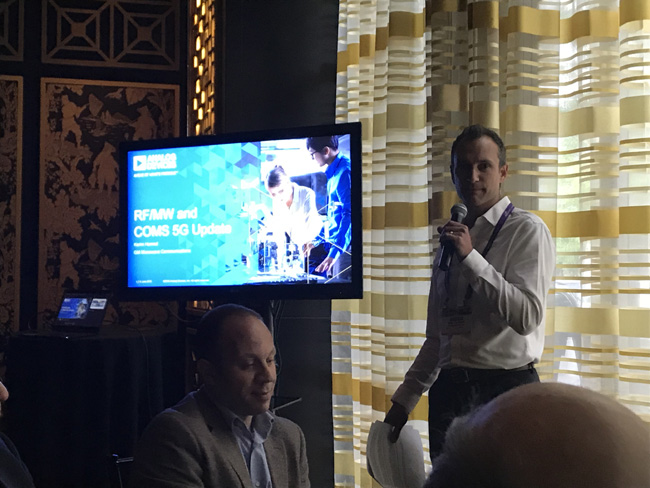 Analog Devices introduced the ADMV1013, a wideband, microwave upconverter optimized for point to point microwave radio designs operating in the 24 GHz to 44 GHz frequency range. The upconverter offers two modes of frequency translation. The device is capable of direct conversion to RF from baseband in-phase quadrature (I/Q) input signals, as well as single-sideband (SSB) upconversion from complex intermediate frequency (IF) inputs. The baseband I/Q input path can be disabled and modulated complex IF signals, anywhere from 0.8 GHz to 6.0 GHz, can be inserted in the IF path and upconverted to 24 GHz to 44 GHz while suppressing the unwanted sideband by typically better than 26 dBc.
Analog Devices introduced the ADMV1013, a wideband, microwave upconverter optimized for point to point microwave radio designs operating in the 24 GHz to 44 GHz frequency range. The upconverter offers two modes of frequency translation. The device is capable of direct conversion to RF from baseband in-phase quadrature (I/Q) input signals, as well as single-sideband (SSB) upconversion from complex intermediate frequency (IF) inputs. The baseband I/Q input path can be disabled and modulated complex IF signals, anywhere from 0.8 GHz to 6.0 GHz, can be inserted in the IF path and upconverted to 24 GHz to 44 GHz while suppressing the unwanted sideband by typically better than 26 dBc.
ADI also introduced a new solution for mmWave 5G with the highest available level of integration to reduce design requirements and complexity in the next generation of cellular network infrastructure. The solution combines ADI’s advanced beamformer IC, up/down frequency conversion (UDC), and additional mixed signal circuitry. This optimized “Beams to Bits” signal chain represents a unique set of capabilities only available from ADI. The new mmWave 5G chipset includes the 16-channel ADMV4821 dual/single polarization beamformer IC, 16-channel ADMV4801 single-polarization beamformer IC and the ADMV1017 mmWave UDC. The 24- to 30-GHz beamforming + UDC solution forms a 3GPP 5G NR compliant mmWave front-end to address the n261, n257 and n258 bands. The high channel density, coupled with the ability to support both single- and dual-polarization deployments, greatly increases system flexibility and reconfigurability for multiple 5G use cases while best-in-class equivalent isotropically radiated power (EIRP) extends radio range and density. ADI’s heritage in mmWave allows customers to take advantage of world class applications and system design to optimize complete lineups for thermal, RF, power and routing considerations.
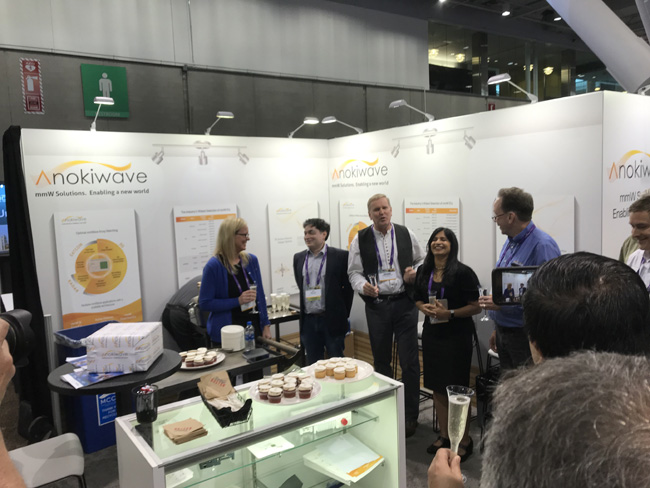 Anokiwave featured the industry’s most advanced and complete portfolio of Silicon ICs for mmWave 5G, SATCOM, and RADAR applications. This year marks Anokiwave’s 20th anniversary as well as the release of its 3rd generation of mmWave dual polarization 5G Beamformer ICs (BFIC), IF Up/Down Converters (IFICs), and 2nd generation of K/Ka and Ku Band SATCOM BFICs. Anokiwave senior staff will be present and available for meetings during the show. Utilizing a 300 mm Silicon CMOS process, Anokiwave ICs provide the optimum balance of low cost and high-performance. Thereby, today Anokiwave is the industry’s trusted provider of mmWave Silicon ICs for high volume commercial deployments of 5G and SATCOM systems worldwide.
Anokiwave featured the industry’s most advanced and complete portfolio of Silicon ICs for mmWave 5G, SATCOM, and RADAR applications. This year marks Anokiwave’s 20th anniversary as well as the release of its 3rd generation of mmWave dual polarization 5G Beamformer ICs (BFIC), IF Up/Down Converters (IFICs), and 2nd generation of K/Ka and Ku Band SATCOM BFICs. Anokiwave senior staff will be present and available for meetings during the show. Utilizing a 300 mm Silicon CMOS process, Anokiwave ICs provide the optimum balance of low cost and high-performance. Thereby, today Anokiwave is the industry’s trusted provider of mmWave Silicon ICs for high volume commercial deployments of 5G and SATCOM systems worldwide.
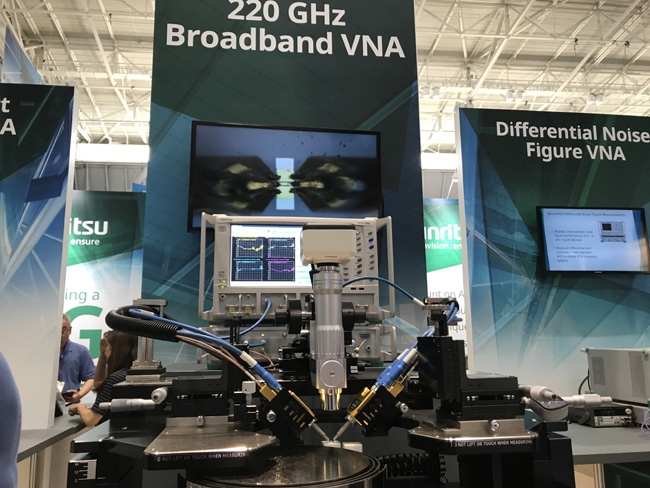 Anritsu showcased the VectorStar in the microwave industry’s first broadband system that supports 70 kHz to 220 GHz in a single sweep. It wasthe first public showing of the solution that addresses the testing requirements to verify chipsets, components, and systems associated with today’s high-speed, high-frequency commercial and military applications. The official launch of the VectorStar 220 GHz system is slated for later in 2019. They also featured updates to their Shockline VNAs and other products.
Anritsu showcased the VectorStar in the microwave industry’s first broadband system that supports 70 kHz to 220 GHz in a single sweep. It wasthe first public showing of the solution that addresses the testing requirements to verify chipsets, components, and systems associated with today’s high-speed, high-frequency commercial and military applications. The official launch of the VectorStar 220 GHz system is slated for later in 2019. They also featured updates to their Shockline VNAs and other products.
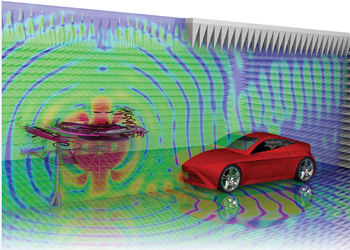 ANSYS showed how 5G communication systems, Advanced Driver Assistance Systems (ADAS), IoT and other high-performance wireless and digital systems are driving high-levels of integration, pushing the limits of battery life, and continuing the drive to design smaller electronic components. Their simulation software will help you meet these design challenges. ANSYS is a leading standard software for the design of RF/microwave components, signal integrity, power integrity, EMI analysis and electronics reliability.
ANSYS showed how 5G communication systems, Advanced Driver Assistance Systems (ADAS), IoT and other high-performance wireless and digital systems are driving high-levels of integration, pushing the limits of battery life, and continuing the drive to design smaller electronic components. Their simulation software will help you meet these design challenges. ANSYS is a leading standard software for the design of RF/microwave components, signal integrity, power integrity, EMI analysis and electronics reliability.
ANSYS is accelerating, streamlining and simplifying the product life cycle through new functionalities released in ANSYS 2019 R2. With ANSYS® Mechanical™ user experience, simplified simulation of complex electronics and a new ANSYS® Fluent™ workflow that significantly speeds meshing of dirty geometries, ANSYS' pervasive simulation engineering solutions enable digital transformation — speeding customers' innovations and reducing their time to market. With new functionalities in ANSYS 2019 R2, including new materials capabilities for structural analysis following the recent acquisition of Granta, ANSYS' simulation solutions accelerate collaboration, validation and verification — creating a reliable digital thread between all operations.
API Technologies featured the new OPTO-FIRE™ micro-optical transceiver from API Technologies enables the improvement of critical data communication systems in airborne, naval, and renewable energy applications. With a range of high-speed data rates (20 Mbs to 25 Gbs), multiple-channels & protocol agnostic architecture, the OPTO-FIRE™ micro-optical transceivers are specifically designed for harsh environment applications. OPTO-FIRE™ is a major change in optical core technology which enables significant size and weight reductions. Available in customized rugged packaging styles to withstand harsh -58 to +212 degrees F operating temperature requirements. Designed and manufactured in the U.K., The OPTO-FIRE™ transceiver product portfolio offers a replacement for traditional copper cabling while delivering proven error free performance up to 1.1km of multimode fibre, is rad tolerant & has a low power consumption (130mW/chl).
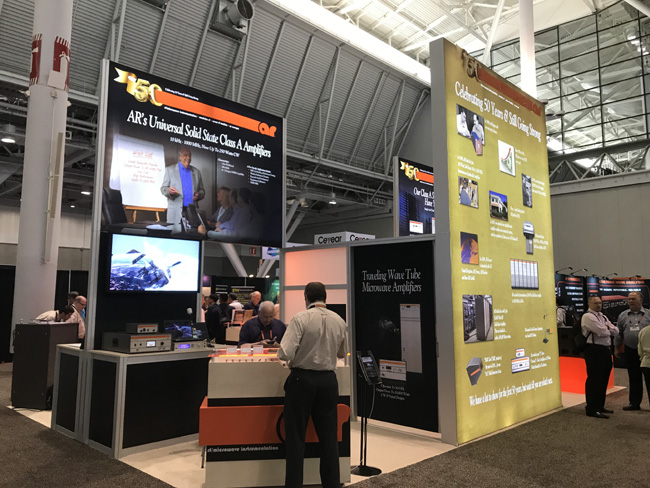 AR highlighted its latest ultra-wideband, cost effective Universal 10 kHz – 1000 MHz solid state power amplifiers, now to 250 W. Excellent for EMC, lab use, R&D, medical, wireless, and scientific applications. AR is the leader in supplying the highest power solid-state CW amplifiers and has delivered a Class A RF amplifier capable of delivering over 50,000 watts with excellent harmonic performance of -40 dBc minimum.
AR highlighted its latest ultra-wideband, cost effective Universal 10 kHz – 1000 MHz solid state power amplifiers, now to 250 W. Excellent for EMC, lab use, R&D, medical, wireless, and scientific applications. AR is the leader in supplying the highest power solid-state CW amplifiers and has delivered a Class A RF amplifier capable of delivering over 50,000 watts with excellent harmonic performance of -40 dBc minimum.
Another recent milestone is a 10,000 W linear amplifier covering the entire 80 to 1000 MHz frequency band.
They also showcased their ultra-wideband single amplifier 0.7 to 6 GHz, hybrid power modules and bench-top amplifiers in both Class A and Class AB designs. These single band amplifiers incorporate the latest GaN devices, and utilize chip and wire technology, proprietary combining techniques, and are manufactured in our microelectronics hybrid facility. Dual band units covering the 1-18 GHz band will also be on display.
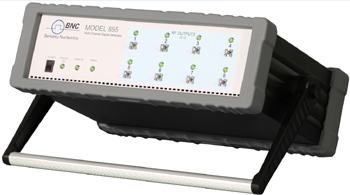 Berkeley Nucleonics introduced a top performing 40 GHz Multi-Channel Signal Generator. Visit them for a first hand demonstration of phase coherent frequency switching, a unique advancement in multi-channel RF/Microwave Signal Generators. Model 855B Series 2-Channel, 4-Channel, and 8-Channel RF/Microwave Signal Generators expand testing capability by enabling multiplexing, increasing data throughput and improving signal-to-noise ratios. The growing need for testing multiple channels in multi-antenna applications is driving new signal simulation and characterization capabilities. The ultra-compact Model 855B offers superior performance in several critical areas. The new design increases power range to an impressive -80 to 25 dBm on each output. The operator’s frequency selection has been expanded to 300 kHz – 40 GHz and ultra-fast switching speeds are now down to 25 uS. The new design boasts a very respectable Phase Noise measurement of -150 dBc/Hz at a 100 kHz offset from a 1 GHz carrier (-100 dBc/Hz at 10 Hz offset).
Berkeley Nucleonics introduced a top performing 40 GHz Multi-Channel Signal Generator. Visit them for a first hand demonstration of phase coherent frequency switching, a unique advancement in multi-channel RF/Microwave Signal Generators. Model 855B Series 2-Channel, 4-Channel, and 8-Channel RF/Microwave Signal Generators expand testing capability by enabling multiplexing, increasing data throughput and improving signal-to-noise ratios. The growing need for testing multiple channels in multi-antenna applications is driving new signal simulation and characterization capabilities. The ultra-compact Model 855B offers superior performance in several critical areas. The new design increases power range to an impressive -80 to 25 dBm on each output. The operator’s frequency selection has been expanded to 300 kHz – 40 GHz and ultra-fast switching speeds are now down to 25 uS. The new design boasts a very respectable Phase Noise measurement of -150 dBc/Hz at a 100 kHz offset from a 1 GHz carrier (-100 dBc/Hz at 10 Hz offset).
 Cadence invited attendees to explore their products and solutions for multi-fabric design, analysis, and verification, including innovations in electromagnetic (EM) analysis and cross-fabric implementation. Visitors could learn about new design techniques such as RFIC and RF module co-design flows with the Virtuoso RF Solution, Edit-in-Concert™ technology for simultaneous editing of multiple ICs and modules across technologies, how to accurately analyze the most complex EM challenges with the new Clarity™ 3D Solver, and how to streamline EM analysis across fabrics including combining EM models and RC parasitics. Additionally, Cadence will host a number of MicroApps presentations, a workshop, and in-booth presentations with topics including system clarity with cross-fabric EM analysis, advanced packaging, concurrent layout editing of RFIC and RF modules, and chip, package, and PCB co-analysis for 5G mmWave front ends.
Cadence invited attendees to explore their products and solutions for multi-fabric design, analysis, and verification, including innovations in electromagnetic (EM) analysis and cross-fabric implementation. Visitors could learn about new design techniques such as RFIC and RF module co-design flows with the Virtuoso RF Solution, Edit-in-Concert™ technology for simultaneous editing of multiple ICs and modules across technologies, how to accurately analyze the most complex EM challenges with the new Clarity™ 3D Solver, and how to streamline EM analysis across fabrics including combining EM models and RC parasitics. Additionally, Cadence will host a number of MicroApps presentations, a workshop, and in-booth presentations with topics including system clarity with cross-fabric EM analysis, advanced packaging, concurrent layout editing of RFIC and RF modules, and chip, package, and PCB co-analysis for 5G mmWave front ends.
Century Seals, a glass to metal seal and hermetics company, introduced two new products at IMS 2019. First, a 50 Ohm RF feedthrough with a .006" diameter pin. This hermetic feedthrough is capable of operating at frequencies up to 90 GHz. CSI is partnering with Signal Microwave who will supply mating connectors. Second, CSI introduced their CRGS (Ceramic Reinforced Glass Seal - patent pending) product which combines glass and ceramic at the seal point creating a seal impervious to cracking.
Cinch Connectivity Solutions, part of Bel, featured four recognized RF/microwave brands at IMS: Johnson, Midwest Microwave, Semflex and Trompeter. Johnson designs 50 and 75 Ω coaxial connectors and adapters; Midwest Microwave manufacturers passive coaxial microwave components for military and commercial systems; Semiflex supplies RF/microwave cables, cable assemblies and connectors up to 120 GHz; and Trompeter provides connectors, patch jacks, cable assemblies, HDTV digital technology and DS3 connectivity solutions for telecom, central office, broadcast, instrumentation and aerospace and defense applications.
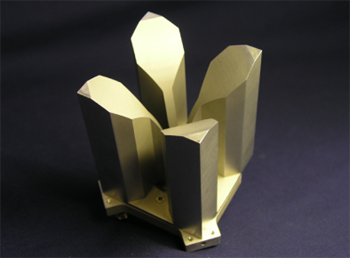 Cobham Advanced Electronic Solutions’ displayed its new Cross Notch Antenna Model Number 94800568 that is a dual-linear, high power, crossed notch antenna. This antenna offers breakthrough performance and is suitable for airborne and high-power ECM applications. In addition, it is also suitable for feeding reflector antennas, wide-band antenna arrays and other broadband applications.
Cobham Advanced Electronic Solutions’ displayed its new Cross Notch Antenna Model Number 94800568 that is a dual-linear, high power, crossed notch antenna. This antenna offers breakthrough performance and is suitable for airborne and high-power ECM applications. In addition, it is also suitable for feeding reflector antennas, wide-band antenna arrays and other broadband applications.
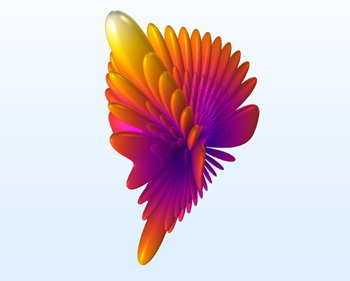 COMSOL showcased how its multiphysics simulation software promotes faster antenna evaluation with the latest features introduced in the RF Module, a high-frequency electromagnetic (EM) simulation add-on tool now available in COMSOL Multiphysics version 5.4. Simulation and design engineers could stop by their booth to discuss applications for a number of markets such as communication, automotive, Internet of Things (IoT), and virtual reality using multiphysics modeling. COMSOL Multiphysics version 5.4 features the following highlights for microwave & RF designers:
COMSOL showcased how its multiphysics simulation software promotes faster antenna evaluation with the latest features introduced in the RF Module, a high-frequency electromagnetic (EM) simulation add-on tool now available in COMSOL Multiphysics version 5.4. Simulation and design engineers could stop by their booth to discuss applications for a number of markets such as communication, automotive, Internet of Things (IoT), and virtual reality using multiphysics modeling. COMSOL Multiphysics version 5.4 features the following highlights for microwave & RF designers:
- Postprocessing workflows and variables for antenna-array radiation-pattern analysis
- Simulation domain transformation utilizing time-to-frequency and frequency-to-time fast Fourier transform (FFT)
- Expanded material library for microwave and millimeter-wave (mmWave) circuit boards
- Application library updates through the deployment of commercially available connectors in the RF Part Library
- Improved user experience for defining ports
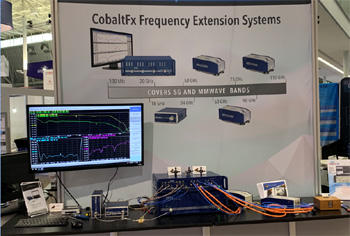 Copper Mountain showed a CobaltFx system with a C4409 VNA (4-port, 100 kHz to 9 GHz) and FET1854 Frequency Extension Modules (18 to 54 GHz) on ports 1 & 2 to demonstrate vector mixer measurements and FEV-15 Frequency Extension Modules (50 to 75 GHz) on ports 3 & 4 to demonstrate filter measurements. The vector mixer measurement setup had a reference mixer to allow transmission phase measurements and a low pass filter to reject the unnecessary image signals. Additionally, the LO was supplied from an external source to the LO port of the two mixers via a splitter. Two calibrations were performed for this setup: first, a full 2-port calibration at the ports of the two extension modules, and then a second-tier calibration using open, short and load standards to de-embed the reference mixer setup. Finally, the measurements shown were conversion loss, group delay and return loss measurements of the mixer under test. The second setup on ports 3 & 4 of the CobaltFx system shows a band pass filter measurement. By switching to FEV-15 under the ‘Frequency Extender’ menu option on the VNA software, we were able to quickly take measurements in the FEV-15 band without reconfiguring the physical setup. For calibration, a full 2-port calibration was performed using the FEV-15 waveguide calibration kit to achieve highest accuracy. The final measurements shown were return loss and insertion loss of a WR-15 filter. Complex measurements such as vector mixer measurements can be performed just like a base VNA. The setup also demonstrated the use of one 4-port VNA to drive two different sets of frequency extension modules. Copper Mountain Technologies also offers a customizable multi-port network analysis solution that builds on the capabilities of the 1-Port USB vector network analyzers (cable and antenna analyzers) named RNVNA. This solution includes a software application that runs on Windows computer or tablet and links up to 16 1-Port analyzers together into a customizable multi-port network analysis system. Designed with cable and antenna testing in mind, RNVNA is compatible with all of Copper Mountain Technologies’ 1-Port USB VNAs, allowing users to measure vector reflection (S11, S22, S33, ...) and scalar transmission parameters (S21, S31, S41…). 1-Port VNA models are available in frequency ranges from 1 MHz to 18 GHz.
Copper Mountain showed a CobaltFx system with a C4409 VNA (4-port, 100 kHz to 9 GHz) and FET1854 Frequency Extension Modules (18 to 54 GHz) on ports 1 & 2 to demonstrate vector mixer measurements and FEV-15 Frequency Extension Modules (50 to 75 GHz) on ports 3 & 4 to demonstrate filter measurements. The vector mixer measurement setup had a reference mixer to allow transmission phase measurements and a low pass filter to reject the unnecessary image signals. Additionally, the LO was supplied from an external source to the LO port of the two mixers via a splitter. Two calibrations were performed for this setup: first, a full 2-port calibration at the ports of the two extension modules, and then a second-tier calibration using open, short and load standards to de-embed the reference mixer setup. Finally, the measurements shown were conversion loss, group delay and return loss measurements of the mixer under test. The second setup on ports 3 & 4 of the CobaltFx system shows a band pass filter measurement. By switching to FEV-15 under the ‘Frequency Extender’ menu option on the VNA software, we were able to quickly take measurements in the FEV-15 band without reconfiguring the physical setup. For calibration, a full 2-port calibration was performed using the FEV-15 waveguide calibration kit to achieve highest accuracy. The final measurements shown were return loss and insertion loss of a WR-15 filter. Complex measurements such as vector mixer measurements can be performed just like a base VNA. The setup also demonstrated the use of one 4-port VNA to drive two different sets of frequency extension modules. Copper Mountain Technologies also offers a customizable multi-port network analysis solution that builds on the capabilities of the 1-Port USB vector network analyzers (cable and antenna analyzers) named RNVNA. This solution includes a software application that runs on Windows computer or tablet and links up to 16 1-Port analyzers together into a customizable multi-port network analysis system. Designed with cable and antenna testing in mind, RNVNA is compatible with all of Copper Mountain Technologies’ 1-Port USB VNAs, allowing users to measure vector reflection (S11, S22, S33, ...) and scalar transmission parameters (S21, S31, S41…). 1-Port VNA models are available in frequency ranges from 1 MHz to 18 GHz.
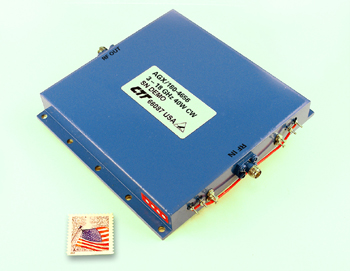 CTT exhibited a family of GaN and GaAs-based solid-state power amplifiers designed for commercial, industrial and military applications.
CTT exhibited a family of GaN and GaAs-based solid-state power amplifiers designed for commercial, industrial and military applications.
- New 600 W X-Band Radar Power Amplifier - CTT’s new X-Band solid-state GaN-based power amplifier, Model AGN/098-5864-P, is designed specifically to meet the demands of the latest synthetic aperture radar (SAR) requirements. Providing more than 600 W pulsed [10% duty] at 9.5 GHz, in a compact package, 6.17-in (L) X 6.60-in (W) X 0.82-in [H]. This new power amplifier design makes an especially attractive choice for new SAR designs where SWaP is at a premium, including many UAV applications.
- New 40 W Multi-Band Power Amplifier - CTT’s new solid-state GaN-based power amplifier, Model AGX/180-4656, covers 3.0 to 18.0 GHz with 40 W of CW power output. The compact size of 5.16-in (L) x 4.90-in (W) x 0.28-in (H) offers RF/Microwave designers an excellent choice for SWaP solutions in many applications, including EW jammers, and for transmit power in multi-band SATCOM terminals.
 Custom MMIC had a live demonstration of their flagship Ultra-Low Noise Amplifier (CMD283) that boasts the industry’s lowest noise figure of 0.6 dB. They introduced four new MMIC devices to our growing portfolio of standard products that now numbers over 170. These new products further demonstrate Custom MMIC's commitment to continuous innovation and delivering the highest performing RF and Microwave MMICs in the industry.
Custom MMIC had a live demonstration of their flagship Ultra-Low Noise Amplifier (CMD283) that boasts the industry’s lowest noise figure of 0.6 dB. They introduced four new MMIC devices to our growing portfolio of standard products that now numbers over 170. These new products further demonstrate Custom MMIC's commitment to continuous innovation and delivering the highest performing RF and Microwave MMICs in the industry.
The new products included the CMD285C3 that is a DC-20 GHz Variable Voltage Attenuator in a Ceramic QFN (3mm x 3mm), the CMD295C4 that is a 2-20 GHz Driver Amplifier in a Ceramic QFN (4mm x 4mm), the CMD298C4 that is a 17-25 GHz Low Noise Amplifier in a Ceramic QFN (4mm x 4mm) and the CMD302C4 that is a DC-20 GHz Switch (SP4T) in a Ceramic QFN (4 mm x 4 mm). They are working on an impressive DC to 70 GHz distributed amplifier with very flat gain and some other very interesting products.
Finally, Custom MMIC teamed with X-Microwave and TI to proto-type a X-Band radar demonstrator. It matches Custom MMIC RF front end devices with TI's ADC and DAC products to make a complete signal chain proto-typed on X-Microwave's breadboard platform.
Dalicap is a source of microwave/RF High-Q (>10,000) MLCC, regular MLCC, broadband MLCC and SLC, and is dedicated to the design and manufacture of customized products such as MLCC c/w microstrip, ribbon, etc. After years’ development, Dalicap is one of the leading suppliers of Hi-Q MLCC, which is being widely used in the industry for applications such as 5G power amplifiers, MRI coils, semiconductors, high-speed railways, filters, Plasma igniters, television & broadcast transmitters, etc. To facilitate their customer’s R&D, standard design kits are also available. Besides standard Hi-Q MLCC, products sized larger than 70B, with microstrip, ribbon or wire are also the best sellers, inclusive of non-magnetic types.
Dynawave was showing its PhaseTite cable assemblies that are well suited for use in radar or military applications. Using a proprietary dielectric technology (DynaCore), the assemblies are phase stable over temperature (as compared to PTFE-based products), so the company targets them at applications where phase stability is critical over temperature for system performance. Also in the booth, Dynawave had its ArcTite ultra-low-profile cable assemblies that maintain electrical performance with ticht bends (without the need for supplemental strain relief boots). These cables allow the use of straight connectors versus right0angle ones, so users can save expense and avoid degraded performance.
Eastern OptX is introducing Model 1250 Radar Target Simulator is a digital propagation path replicator. The 1250 will produce a moving target with appropriate target cross-section, propagation loss, with a dynamic range of over 50 dB. The 1250 operates with pulsed, frequency hopping, or CW radars and with any encryption or modulation scheme. A high speed, user defined scenario may be triggered from the detected radar pulse or a user supplied eternal pulse, The 1250 will provide coherent operation with user supplied LO.
Nova Microwave, under the ElectroTechnik company, recently announced the release of the DKIU3325 broad band isolator. The new DKIU3325 isolator operates from 26.5 to 40 GHz and it can handle 5 W of forward average power. This high-performance isolator is available with 2.92 mm (K) connectors.
Element Six, known for developing synthetic diamond materials, announced a new diamond material, Diafilm TM220, with a thermal conductivity greater than 2200 W/mK. This thermally isotropic CVD diamond addresses the need for higher thermal conductivity packaging for high power density semiconductor devices, such as GaN PAs, ASICs and FPGAs used in wireless infrastructure and defense systems.
Empower RF is continuing its quest to develop “intelligent” high power amplifiers capable of handling complex waveforms with high linearity. Since last year’s IMS, Empower has been extending its portfolio in both output power and frequency coverage. At this year’s IMS, the company featured a new GaN PA covering 0.6 to 6 GHz with 40 W output power (typical). Empower says it is the first to cover this extended frequency range with an affordable, off-the-shelf PA.
 Focus Microwaves had Dr. Tushar Sharma presenting his work on input-output controlled continuous mode GaN Power amplifiers, "Investigation of Input-Output Waveform Engineered Continuous Inverse Class F Power Amplifiers " The work has been carried out in collaboration with University of Calgary, and Focus Microwaves. Focus Microwaves’ new DELTA series of electro-mechanical tuners is designed specifically for high frequency on wafer measurements. The tuner’s low profile allows it to be placed within the wafer perimeter and allows for a direct connection between the probe tip and the tuner, eliminating all possible insertion loss between the DUT and the tuner. This revolutionary new tuner design enables the engineer to achieve optimum tuning range, with a tuner whose footprint and weight has been dramatically reduced.
Focus Microwaves had Dr. Tushar Sharma presenting his work on input-output controlled continuous mode GaN Power amplifiers, "Investigation of Input-Output Waveform Engineered Continuous Inverse Class F Power Amplifiers " The work has been carried out in collaboration with University of Calgary, and Focus Microwaves. Focus Microwaves’ new DELTA series of electro-mechanical tuners is designed specifically for high frequency on wafer measurements. The tuner’s low profile allows it to be placed within the wafer perimeter and allows for a direct connection between the probe tip and the tuner, eliminating all possible insertion loss between the DUT and the tuner. This revolutionary new tuner design enables the engineer to achieve optimum tuning range, with a tuner whose footprint and weight has been dramatically reduced.
At the Frontlynk booth, many attendees were interested in the company’s 1.0 mm series which includes adaptors, end launch, connectors, and cable assemblies for applications in the 110 GHz band. The company also offers customization and assistance to customers from the prototype stage all the way through mass production.
Gigalane was showing its Kevlar MW/RF coaxial cable and connectors up to 67 GHz that are in compliance with MIL standards and target applications in aerospace, military, broadband, instrumentation, and telecom.
GLOBALFOUNDRIES (GF) and Analog Bits announced the availability of Analog Bits analog and mixed signal IP design kits for GF’s 12nm Leading-Performance (12LP) process technology. Through collaboration with GF, the IP portfolio includes wide range fractional Phase-Lock Loop (PLL) with Spread Spectrum Clock Generation (SSCG), PCIe reference clock PLL subsystem, Process, Voltage, and Temperature (PVT) Sensor and Power-On-Reset (POR) circuitry. Silicon Reports based on these IPs will be available 2Q 2020, and first customer tape-out is expected in 2H 2020.
GF and Soitec announced that they have signed multiple long-term supply agreements for 300mm silicon-on-insulator (SOI) wafers to secure the high-volume supply to meet the growing demand from GF customers for its differentiated radio-frequency-silicon-on-insulator (RF-SOI), fully-depleted-silicon-on-insulator (FD-SOI) and silicon photonics technology platforms. The agreements, which take effect immediately, build on the existing close relationship between the companies to ensure state-of-the-art high-volume manufacturing for years to come.
RFIC supplier Guerrilla RF continues its double-digit growth through its willingness to support unique customer needs and provide strong applications support. Developing products for the automotive market is one area of focus, with Guerrilla RF releasing four RFICs meeting AEC-Q100 Class 2 qualification since the start of the year. The most recently qualified products are a high gain low noise amplifier for 802.11ac, with less than 1 dB noise figure, and a broadband gain block covering 700 MHz to 3.8 GHz. At IMS, the company introduced its first two high efficiency InGaP HBT PAs. The first delivers up to 3.5 W saturated output power with 64 percent power-added efficiency (PAE), when tuned to a fractional bandwidth between 3 and 5 percent across 400 to 500 MHz. A second PA delivers just under 5 W saturated output with 58 percent PAE when tuned to a fractional bandwidth between 3 and 5 percent between 700 and 1000 MHz.
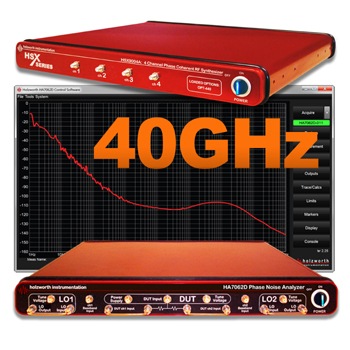 Holzworth Instrumentation showcased its new 40 GHz RF Synthesizer and Phase Noise Analyzer products at IMS in Boston, in support of 5G manufacturing test and R&D efforts where high speed data fidelity is critical. The HSX Series RF Synthesizers offer incredible spectral purity and phase noise performance. These unique multi-channel, phase coherent synthesizers offer industry leading channel-channel phase stability in a 1U chassis. The newly released 40 GHz options offer broadband performance from 10 MHz to 40 GHz (1 mHz step size), while complimenting the lower frequency options of 3, 6, 12 and 24 GHz.
Holzworth Instrumentation showcased its new 40 GHz RF Synthesizer and Phase Noise Analyzer products at IMS in Boston, in support of 5G manufacturing test and R&D efforts where high speed data fidelity is critical. The HSX Series RF Synthesizers offer incredible spectral purity and phase noise performance. These unique multi-channel, phase coherent synthesizers offer industry leading channel-channel phase stability in a 1U chassis. The newly released 40 GHz options offer broadband performance from 10 MHz to 40 GHz (1 mHz step size), while complimenting the lower frequency options of 3, 6, 12 and 24 GHz.
The HA7062D 40 GHz Real Time Phase Noise Analyzer is the only phase noise analyzer available with real time FFT data analysis that covers the entire 100MHz offset measurement bandwidth. In addition to pure measurement speed, Holzworth's phase noise analyzers include an ANSI z540 calibration and focus on data accuracy, repeatability and reliability.
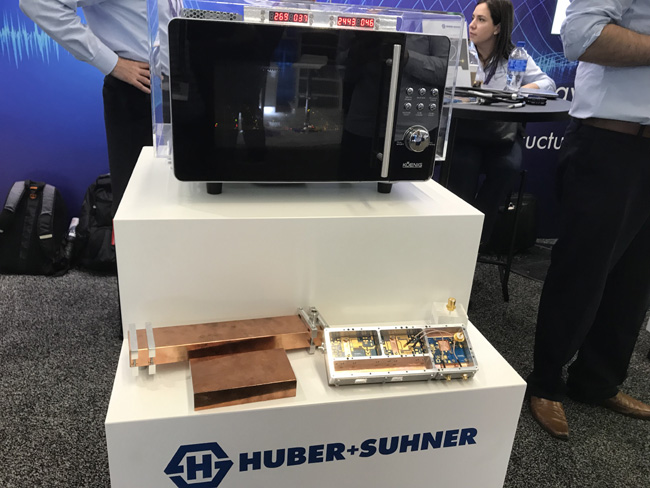 HUBER+SUHNER, a leading expert in RF connectivity, has reinforced its commitment to developing products dedicated for solid-state RF Energy applications as it became one of eight companies to found the International Microwave Power Institute’s (IMPI’s) new Solid State RF Energy Section. The Alliance shifted over to IMPI late last year. With significant advantages over existing solutions, such as magnetrons, high-power Radio Frequency (RF) applications are on the cusp of transforming to solid-state RF Energy in many vertical markets – but pushing a new technology into new and existing markets also presents challenges. As part of IMPI’s Solid State RF Energy Section, HUBER+SUHNER is dedicated to endorsing solid-state RF Energy’s true potential as a clean, highly efficient and controllable heat and power source. On the cable side, they were featuring the PSM connector (Power Sub Miniature) interface that meets the increasing demand for cost effective, low weight and power sensitive A&D applications. The PSM connector system enables customers to maximize overall system weight.
HUBER+SUHNER, a leading expert in RF connectivity, has reinforced its commitment to developing products dedicated for solid-state RF Energy applications as it became one of eight companies to found the International Microwave Power Institute’s (IMPI’s) new Solid State RF Energy Section. The Alliance shifted over to IMPI late last year. With significant advantages over existing solutions, such as magnetrons, high-power Radio Frequency (RF) applications are on the cusp of transforming to solid-state RF Energy in many vertical markets – but pushing a new technology into new and existing markets also presents challenges. As part of IMPI’s Solid State RF Energy Section, HUBER+SUHNER is dedicated to endorsing solid-state RF Energy’s true potential as a clean, highly efficient and controllable heat and power source. On the cable side, they were featuring the PSM connector (Power Sub Miniature) interface that meets the increasing demand for cost effective, low weight and power sensitive A&D applications. The PSM connector system enables customers to maximize overall system weight.
HYPERLABS displayed its extensive line of components, including a 40 GHz resistive pick-off tee with a rise time less than 9 ps. The HL9465 has a through-line insertion loss of approximately 4 dB, a pick-off level of −14 dB and return loss generally better than 10 dB over the full bandwidth of 40 GHz. A matched pair of resistive tee is available for differential applications requiring equal propagation delays, designated HL9465M.
Another fabless MMIC start-up, ICONIC RF, announced two MMIC PAs with high back-off efficiency for 5G mmWave and satellite applications: 1) a 5 W, single-ended, two-stage GaN PA covering 24 to 31 GHz with greater than 40 percent PAE and 2) a GaAs MMIC Doherty PA covering 24 to 27.5 GHz, delivering 28.5 dBm output power with greater than 35 percent PAE at full output and 21 percent at 8 dB output back-off. ICONIC RF was formed in December 2018 and is based in Belfast, Northern Ireland.
IDT, recently acquired by Renesas, is in the midst of being integrated into the larger company. Nonetheless, RF remains a core strategy, and IDT is expanding its focus from silicon RFICs for sub-6 GHz cellular infrastructure to mmWave applications, such as 5G infrastructure, SatCom and radar. IDT’s process technology will no longer be restricted to silicon, now including GaAs and GaN. At IMS, IDT demonstrated its entry in the 28 GHz beamforming race, an 8-channel front-end, the first of a family that will cover all the 5G bands.
 In-Phase Technologies announced four new Core Test Sets, the first commercial test sets of this type available to the high-frequency ATE market. Analog and digital test systems are already embracing the new concept of Core Test Sets. Core Test Sets save money through their ease of configurability. Now it’s time for the microwave and RF Automated Test Equipment (ATE) community to do the same, to meet a gap in the industry. With In-Phase Technologies’ pre-configured Core Test Sets, test engineers will cut test set development time in half. They also save on development time, manufacturing, and documentation costs. In-Phase assures total system signal integrity among all pre-configured building blocks. New Core Test Sets:
In-Phase Technologies announced four new Core Test Sets, the first commercial test sets of this type available to the high-frequency ATE market. Analog and digital test systems are already embracing the new concept of Core Test Sets. Core Test Sets save money through their ease of configurability. Now it’s time for the microwave and RF Automated Test Equipment (ATE) community to do the same, to meet a gap in the industry. With In-Phase Technologies’ pre-configured Core Test Sets, test engineers will cut test set development time in half. They also save on development time, manufacturing, and documentation costs. In-Phase assures total system signal integrity among all pre-configured building blocks. New Core Test Sets:
- Analog/Digital Core Test Set (#1342649) tests avionics products, power supplies, LCR measurements, low frequency boards (<1 GHz), electronic loads, etc.
- Full Transceiver Core Test Set (#1342650) tests digital or analog radios, radars, altimeters, frequency translators, and components
- Amplifier Core Test Set (#1342651) tests high power amplifiers, low noise amplifiers, medium power amplifiers, frequency translators, and components
- Transmitter Core Test Set (#1342652) tests all types of transmitters from analog to digital modulation
- Receiver Core Test Set (#1342653) tests all types of receivers, including analog and digital modulation
Integra Technologies presented a new family of X-band power solutions at IMS. Integra hosted a live demo of the IGT1112M90, a Fully-Matched-to-50-Ohms GaN/SiC RF Power Transistor designed to meet the demanding needs of modern X-band radar systems. The IGT1112M90 operates instantaneously over a frequency range of 10.8-11.8 GHz, delivers a minimum peak output power of 90 W at 50 V drain bias voltage and 11 dB of gain, achieving 43% efficiency. This new family of X-band products positions Integra to address the increasingly challenging needs of the X-band radar market for higher sensitivity, improved resolution, superior detection and smaller form factor.
Junkosha has launched their latest mmWave cabling solution, the MWX004, in a bid to go beyond the 145 GHz barrier, a unique capability in the marketplace and one that places it at the forefront of cable assembly innovation. The MWX004 can use 1.0 mm enhanced connector to 130 GHz and 0.8 mm connector to 145 GHz. They were also featuring their Phase Stability and Slim Cable the MWX161 which operates to 67 GHz. They have small diameter at the neck part adn most suitable for multi-post VNA applications.
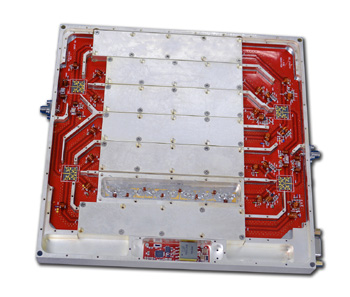 K&L Microwave featured its 7SFB-225/Q512-O that is a 7 channel switched filter bank designed to filter spurious and harmonic content generated by high power amplifiers and transmitters in the UHF band. These interferers can degrade performance and even damage sensitive equipment. As communications band usage and amplifier technology power densities increase, this challenge becomes more formidable. K&L Microwave has leveraged core competencies in PIN diode based switches and high-power filters to develop a suite of high-power switched filter banks. Please consult the factory for custom filters, other bands, or higher power levels.
K&L Microwave featured its 7SFB-225/Q512-O that is a 7 channel switched filter bank designed to filter spurious and harmonic content generated by high power amplifiers and transmitters in the UHF band. These interferers can degrade performance and even damage sensitive equipment. As communications band usage and amplifier technology power densities increase, this challenge becomes more formidable. K&L Microwave has leveraged core competencies in PIN diode based switches and high-power filters to develop a suite of high-power switched filter banks. Please consult the factory for custom filters, other bands, or higher power levels.
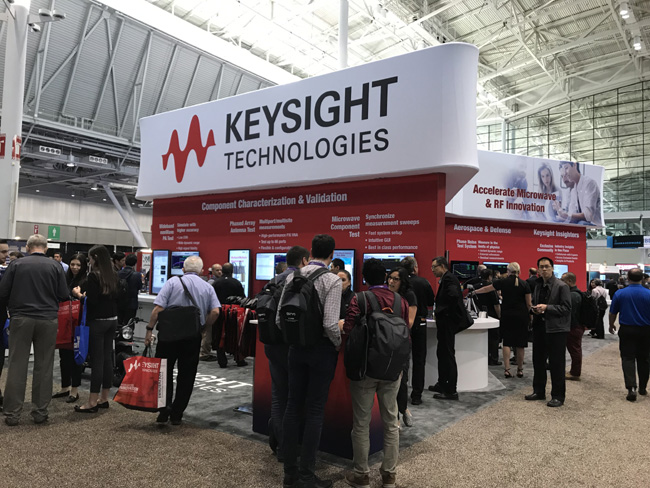 Keysight Technologies announced the optional S93070xB Modulation Distortion application for the company’s PNA-X Vector Network Analyzer, which delivers a wide system dynamic range resulting in the lowest possible residual error vector magnitude (EVM) on the market today. The new S93070xB Modulation Distortion application, which is fully integrated with Keysight’s PNA-X Vector Network Analyzer, enables designers to accurately, repeatably and quickly characterize the behavior of a device under modulated wideband signal stimulus.
Keysight Technologies announced the optional S93070xB Modulation Distortion application for the company’s PNA-X Vector Network Analyzer, which delivers a wide system dynamic range resulting in the lowest possible residual error vector magnitude (EVM) on the market today. The new S93070xB Modulation Distortion application, which is fully integrated with Keysight’s PNA-X Vector Network Analyzer, enables designers to accurately, repeatably and quickly characterize the behavior of a device under modulated wideband signal stimulus.
Keysight also introduced a new phase noise measurement system for “power users”, which enables them to optimize and prove performance of new designs, meet operational requirements, as well as remain on schedule and on budget. The new N5511A Phase Noise Test System (PNTS) models are available in three frequency ranges - from 50 kHz and going up to 3, 26.5, or 40 GHz with offsets from .01 Hz to 160 MHz internally. It can be configured for either single or dual-channel operation.
They also announced the next generation of the company’s multi-purpose, handheld microwave analyzer, the FieldFox B-series, which delivers measurement precision and bandwidth up to 100 MHz for wide-band, real-time spectrum analysis to enable 5G testing in the field. In addition, these new capabilities enable customers to locate and identify the shortest interfering threats to their satellite communication networks. It has 10 dB improvement in displayed average noise level (DANL) for measuring low noise signals and detecting weak interferers and can collect, play back, and analyze raw I/Q data for electronic warfare test.
They also launched the next generation of network analyzers that best-in-class dynamic range, trace noise and temperature stability, as well as a wide range of software applications, enabling engineers to consistently achieve comprehensive device characterization. Keysight’s new E5080B, P50xxA Series, and M980xA Series network analyzers deliver next generation features and performance in benchtop, USB, and PXI form factors.
In a major development, Keysight announced PathWave Design 2020, which includes the latest releases of Keysight’s electronic design automation software to accelerate design workflows for radio frequency (RF) and microwave, 5G, and automotive design engineers. The PathWave Design 2020 software suite includes new releases of flagship products: PathWave Advanced Design System (ADS) 2020, PathWave RFIC Design (GoldenGate) 2020, PathWave System Design (SystemVue) 2020, and PathWave RF Synthesis (Genesys) 2020.
Knowles was showing off their passive solutions for 5G including n257, n258, n260 and n261 frequency bands. To solve these problems, the DLI brand has created a variety of solder mountable (SMD) microwave products. They now have sample kits for SMD band pass filters, power dividers and couplers. They recently published a 5G mmWave filter technology article in the May IMS issue Microwave Journal.
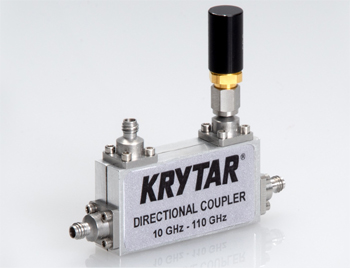 KRYTAR showcased their new breakthrough directional coupler which offers some of widest frequency coverage on the market. Model 1100110010 maintains flat 10 dB coupling across a wide 100 GHz bandwidth. The new directional coupler lends itself to wireless designs and many test and measurement applications for emerging mmWave and 5G markets. This coupler can also be manufactured to meet military specifications. The coupler will find many uses including power monitoring and leveling in many different systems, including antenna beamforming systems, electronic-warfare (EW) systems, electromagnetic-compatibility (EMC) testing, radar systems, and many wireless communications systems. This new coupler further expands the KRYTAR family of directional couplers offering superior coupling performance.
KRYTAR showcased their new breakthrough directional coupler which offers some of widest frequency coverage on the market. Model 1100110010 maintains flat 10 dB coupling across a wide 100 GHz bandwidth. The new directional coupler lends itself to wireless designs and many test and measurement applications for emerging mmWave and 5G markets. This coupler can also be manufactured to meet military specifications. The coupler will find many uses including power monitoring and leveling in many different systems, including antenna beamforming systems, electronic-warfare (EW) systems, electromagnetic-compatibility (EMC) testing, radar systems, and many wireless communications systems. This new coupler further expands the KRYTAR family of directional couplers offering superior coupling performance.
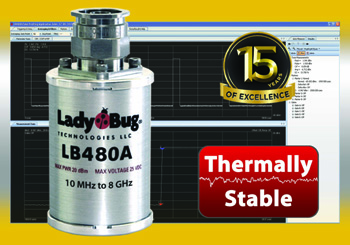 LadyBug showcased a variety of their high accuracy solutions with a focus on system integration. They highlighted their flexible USB and SPI direct-connect power sensor options. The options address power measurement needs of system integration including higher accuracy, reduced size, weight, and power consumption. The SPI option allows users to connect directly to the sensor using SPI or I2C. This eliminates the hardware and software overhead associated with USB connectivity and still delivers an accurate calibrated, power measurement. Customers can build compact test systems that include first-tier NIST traceability along with LadyBug’s patented No-Zero Technology. LadyBug manufactures direct reading pulse sensors along with True-RMS average power sensors. Sensors with ranges from 9 kHz to 40 GHz and 86 dB dynamic range.
LadyBug showcased a variety of their high accuracy solutions with a focus on system integration. They highlighted their flexible USB and SPI direct-connect power sensor options. The options address power measurement needs of system integration including higher accuracy, reduced size, weight, and power consumption. The SPI option allows users to connect directly to the sensor using SPI or I2C. This eliminates the hardware and software overhead associated with USB connectivity and still delivers an accurate calibrated, power measurement. Customers can build compact test systems that include first-tier NIST traceability along with LadyBug’s patented No-Zero Technology. LadyBug manufactures direct reading pulse sensors along with True-RMS average power sensors. Sensors with ranges from 9 kHz to 40 GHz and 86 dB dynamic range.
Lark, a Benchmark company, is a leader in advanced liquid crystal polymer (LCP) next-gen manufacturing methods for the miniaturization of printed circuit boards. Using LCP they can offer a dimensional board space reduction average of 60%, a maximum board reduction of 1/10th the original size and performance up to 100 GHz. Their LCP manufacturing takes place at our newly built RF and High-Speed Design Center of Innovation in Phoenix, where we offer prototyping and design services, substrate and packaging technologies, mixed microelectronics and complex product assembly and test.
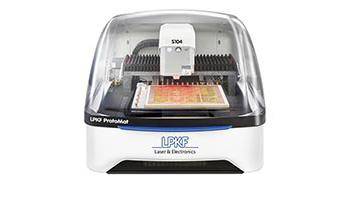 LPKF's 4th generation S-series in-house rapid PCB prototyping equipment is capable of creating traces and spacing as small as 100 μm (4 mil), includes a solid granite-based construction, automated fiducial alignment camera, ceramic base vacuum table, solder paste dispensing and 2.5D pocket milling capabilities as standard features on the new 60,000 RPM ProtoMat S64 model. The ProtoMat S104 model adds a higher speed 100,000 RPM variable speed spindle motor and high-precision copper thickness sensor probe as additional standard features which are ideal for more sensitive materials such as PTFE or ceramic filled PTFE for RF/MW applications. With an automatic tool change and depth sensor, the cut depth can be precisely and automatically controlled with zero operator interaction – the first truly set-it-and-forget-it automated PCB prototyping machines ever.
LPKF's 4th generation S-series in-house rapid PCB prototyping equipment is capable of creating traces and spacing as small as 100 μm (4 mil), includes a solid granite-based construction, automated fiducial alignment camera, ceramic base vacuum table, solder paste dispensing and 2.5D pocket milling capabilities as standard features on the new 60,000 RPM ProtoMat S64 model. The ProtoMat S104 model adds a higher speed 100,000 RPM variable speed spindle motor and high-precision copper thickness sensor probe as additional standard features which are ideal for more sensitive materials such as PTFE or ceramic filled PTFE for RF/MW applications. With an automatic tool change and depth sensor, the cut depth can be precisely and automatically controlled with zero operator interaction – the first truly set-it-and-forget-it automated PCB prototyping machines ever.
Additionally, LPKF will showcase the first-ever table-top version of the popular ProtoLaser series; the ProtoLaser ST. The ProtoLaser ST is a compact rapid prototyping laser system. The advanced laser technology and optics result in shortened development time and simple data handling for rapid surface metal removal, making the ProtoLaser ST an ideal solution for RF and microwave PCBs and a complementary partner to any ProtoMat mechanical milling system.
 MACOM announced a new wideband distributed amplifier with the introduction of the MAAM-011238, offered in both bare-DIE and Surface Mount packaged formats. Well suited for use in 5G test and measurement (T&M) equipment, the MAAM-011238 gives system designers the ability to leverage a single amplifier for 5G applications spanning sub-6 GHz to mmW frequencies. It supports wideband operation from 100 kHz up to 50 GHz (67.5 GHz for the Bare-DIE version) with typical gain of 14 dB at 30 GHz. The input and output are fully matched at 50 Ω with typical return loss of 10 dB across the band. They also released the MAAM-011275-DIE amplifier that supports wideband operation from 30 kHz up to 40 GHz with typical gain of 15 dB. The input and output are fully matched at 50 Ω with typical return loss of 13 dB across the band.
MACOM announced a new wideband distributed amplifier with the introduction of the MAAM-011238, offered in both bare-DIE and Surface Mount packaged formats. Well suited for use in 5G test and measurement (T&M) equipment, the MAAM-011238 gives system designers the ability to leverage a single amplifier for 5G applications spanning sub-6 GHz to mmW frequencies. It supports wideband operation from 100 kHz up to 50 GHz (67.5 GHz for the Bare-DIE version) with typical gain of 14 dB at 30 GHz. The input and output are fully matched at 50 Ω with typical return loss of 10 dB across the band. They also released the MAAM-011275-DIE amplifier that supports wideband operation from 30 kHz up to 40 GHz with typical gain of 15 dB. The input and output are fully matched at 50 Ω with typical return loss of 13 dB across the band.
MACOM also demonstrated its W-Band capabilities targeted for mmW communications, radar and passive imaging applications. The W-Band demonstration included a Variable Voltage Attenuator (VVA) with typical variable attenuation range of 25 dB, reflective SP2T Switch with integrated bias circuits and typical Insertion Loss of 0.8 dB, and balanced 3-stage power amplifier with typical Saturated Power of 24 dBm. These all use MaCOM’s AlGaAs PIN Diode technology.
They also announced the MAAP-011250 which is a balanced 4 W, 4-stage power amplifier assembled in a lead-free 5 mm 32-lead AQFN plastic package. This power amplifier operates from 27.5 to 30 GHz and provides 24 dB of linear gain, 4 W saturated output power and output IP3 of 41 dBm while biased at 6 V.
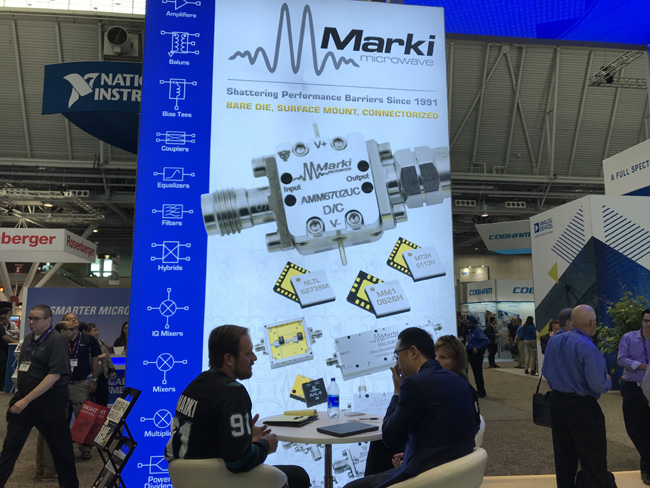 Marki Microwave introduced their first 50 GHz surface mount products, the MM1-1850HSM and MM1-1850SSM double-balanced mixers. These GaAs MMIC mixers offer wide bandwidths and high linearity in a proprietary surface mount package. With an RF bandwidth of 18 to 50 GHz and IF of DC to 21 GHz these are ideally suited for electronic warfare, radar, multi-band 5G, and other K/Ka-band applications. Both mixers offer excellent spurious suppression with the MM1-1850SSM providing the highest linearity with +28 dBm IIP3. The MM1-1850HSM and MM1-1850SSM are offered in a 4x4 mm SMT package. Evaluation boards are also available. They also featured their AMM-6702 which is a broadband MMIC LO buffer amplifier that efficiently provides high gain and output power over a 20-55 GHz frequency band. It is designed to provide a strong, flat output power response when driven with an input power at 0 dBm. It has built-in DC blocking capacitors on the input and output.
Marki Microwave introduced their first 50 GHz surface mount products, the MM1-1850HSM and MM1-1850SSM double-balanced mixers. These GaAs MMIC mixers offer wide bandwidths and high linearity in a proprietary surface mount package. With an RF bandwidth of 18 to 50 GHz and IF of DC to 21 GHz these are ideally suited for electronic warfare, radar, multi-band 5G, and other K/Ka-band applications. Both mixers offer excellent spurious suppression with the MM1-1850SSM providing the highest linearity with +28 dBm IIP3. The MM1-1850HSM and MM1-1850SSM are offered in a 4x4 mm SMT package. Evaluation boards are also available. They also featured their AMM-6702 which is a broadband MMIC LO buffer amplifier that efficiently provides high gain and output power over a 20-55 GHz frequency band. It is designed to provide a strong, flat output power response when driven with an input power at 0 dBm. It has built-in DC blocking capacitors on the input and output.
Massachusetts Bay Technologies now includes full thin film circuit capabilities in their portfolio. MBT has the knowledge and factory infrastructure to support & supply any standard or custom thin film design. Send them your requirements to see how MBT supports you all the way from design inception to meeting your desired costs. Their knowledge and quality cost-cutting methods put MBT first for Thin Film.
- CAD Design
- Thin Film Circuit Design
- Photomask Layout & Design
- Photolithography
- Substrates
- Vias
- Plating
- Sputtering of Resistor Films
- Polyamides
- Laser Trimming
- Dicing
- First Article Inspections
MathWorks presented its latest capabilities and workflows for designing and testing RF, wireless communications, and Radar systems at the show. MathWorks experts will deliver four Industry Workshops, which are 2-hour technical seminars that provide insight into leading edge technologies through in-depth presentations, demonstrations, and interactive engagement with attendees. The session topics are:
- Hybrid Beamforming for 5G Systems
- Introduction to the 5G NR Physical Layer Standard
- Antenna, Array Design and Prototyping Using MATLAB
- Automotive Radar IQ Data Simulation for Performance Analysis
MathWorks demonstrated the integration they now have with MATLAB and NI test hardware. They had a demo showing a Wolfspeed GaN PA being tested and used the DPD algorithms from MATLAB to see the EVM improvement with various models. So now designers can use the simulation and modeling capabilities of MATLAD with NI’s LabVIEW and test systems.
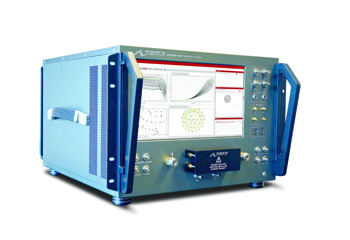 Maury had the most impressive line of new products that we saw. They added the software platform Insight to their Precision Calibration portfolio. Insight represents a paradigm shift in the way users approach VNA calibration, validation, measurement, visualization and analysis because they can use a single software platform with most commercial VNAs (they have demonstrated similar measurements on a Keysight USB VNA and Copper Mountain USB VNA and can support others). Users can also define mechanical calibration standards from any vendor and use with all VNAs, avoid common errors with a simplified calibration using intuitive GUI validate VNA calibration, measure S-parameters and save S2P files, understand measurement results better with advanced visualization and analysis, identify and quantify the individual contributions of uncertainty and display uncertainty boundaries with measurement results
Maury had the most impressive line of new products that we saw. They added the software platform Insight to their Precision Calibration portfolio. Insight represents a paradigm shift in the way users approach VNA calibration, validation, measurement, visualization and analysis because they can use a single software platform with most commercial VNAs (they have demonstrated similar measurements on a Keysight USB VNA and Copper Mountain USB VNA and can support others). Users can also define mechanical calibration standards from any vendor and use with all VNAs, avoid common errors with a simplified calibration using intuitive GUI validate VNA calibration, measure S-parameters and save S2P files, understand measurement results better with advanced visualization and analysis, identify and quantify the individual contributions of uncertainty and display uncertainty boundaries with measurement results
They also updated their VNA calibration kit offering with Characterized Device (CD) fixed-load SOLT cal kits. CK50-series CD cal kits are composed of individually characterized short, open and fixed load standards. Each kit comes with custom S-parameter files which are used for VNA calibration instead of a generalized polynomial definition, resulting in TRL-like accuracy with fixed-load SOLT ease-of-use.
They also introduced CK60-series Verification Kits are designed for 1-port and 2-port VNA calibration validation for well-matched and mismatched DUTs. Each kit comes with individually characterized verification standards and is used for calibration validation by comparing the S-parameters of the individual verification standards measured by the user and the S-parameters measured at the factory. When combining the CK50-series cal kits and CK60-series verification kits with MT940-series Insight Calibration and Measurement Software, users will be able to quantify the uncertainty contribution of their calibration kit to their overall measurement uncertainty.
They recently launched the AM3100-series Pulsed SMU in partnership with AMCAD Engineering. The AM3100 can operate up to 120 V and 30 A pulsed with pulse widths down to 1.1 us. It includes internal and external synchronization and triggering and can be controlled through direct SCPI commands via USB or Ethernet. The AM3100 includes multiple levels of protection circuitry including a fast short-circuit current breaker (e-fuse).
They also updated our MT2000 Mixed-Signal Active Load Pull System to have 1000 MHz of wideband impedance control for 5G FR1 and FR2 and WiFi device characterization. The MT2000 replaces a VNA, NVNA, up to six modulated signal sources, vector signal analyzer, oscilloscope and six automated impedance tuners with a one-box turnkey system. It is also the only commercial load pull solution actually suitable for 5G measurements, and overcomes the well-known limitations of passive load pull and automated impedance tuners.
Their vector-receiver load pull system has been upgraded with new software options for Large Signal Analysis (LSA) and Enhanced PHD (EPHD) behavioral model extraction. LSA and EPHD were designed to help users design advanced circuits by enabling nonlinear large-signal time-domain measurements on most commercial VNAs.
The most exciting announcement was their new partnership with Vertigo Technologies, another spin-off of TU Delft (our partner Anteverta was a spin-off of TU Delft in 2010, and we acquired them in 2015).
MCV Microwave featured their ceramic filters with high Q - low loss, small size and rugged SMT design using discrete resonators and monoblock ceramic covering the frequency range from 300 MHz to 10 GHz. MCV's ceramic filter line includes band pass filter, band reject filter, low pass filter, high pass filter, duplexer, and multiplexer. High Power Ceramic Filters (20-30 W continuous power) are suitable for small cell base station applications such as 4G LTE, public safety and wireless communication in 700 MHz up to 5 GHz. These can be an economical option for cavity filters at a much smaller size.
MegaPhase was discussing its RF and microwave products through 110 GHz, including test and measurement cables, RF and microwave cables, RF components, connectors, adaptors, and accessories. One highlight was its recent announcement of CNC capabilities to guarantee expedited delivery on all prototype and production connector solutions, allowing the company to deliver connectors with precision-grade performance for custom and standard interconnects. From the CNC capability, board launch and cable connectors are available through 110 GHz including 1.85 mm, 1.0 mm, SMPS, and SMP3.
Menlo Micro showcased its latest products at MTT-IMS. On display were:
- Demo boards of its latest high-power RF switches, the MM5120 and MM5130, which have ultra-low insertion loss up to 18 GHz. In some cases, 0.5 dB to 1.0 dB better than solid-state switches.
- The extreme linearity and harmonic performance of its micromechanical devices, in many cases 30 to 40 dB better IP3 and harmonics than solid-state. Menlo Micro also conducted demonstrations of the devices’ high-power handling capability, up to 25 W, and their performance at high temperatures.
- In collaboration with industry partners, Menlo Micro showed off some of the early applications of these high-performance switches, including very low-loss switched filter banks, which can be applied to both military and commercial applications.
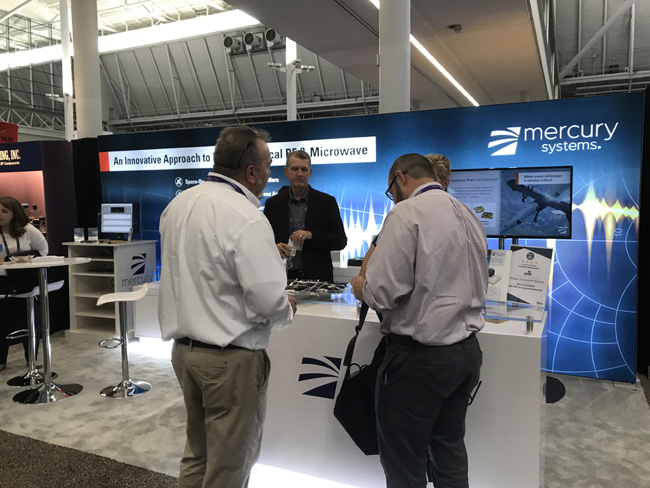 Mercury Systems announced the SpectrumSeries™ DS-3000 synthesizer, the company’s latest high-performance, direct digital synthesis (DDS)-based synthesizer. Designed to support customers’ advanced frequency conversion technology requirements and operate in the harshest environments, the DS-3000 synthesizer offers industry-leading phase noise of -121 dBc/Hz at 10 GHz with 10 kHz offset, and frequency coverage up to 20 GHz with 1 Hz resolution. Ultra-low phase noise synthesizers are critical to electronic warfare (EW) and electronic intelligence (ELINT) systems that monitor large radio frequency (RF) bandwidths through either a channelized architecture or wide instantaneous bandwidth (IBW). Mercury’s DS-3000 synthesizer increases the operational range and performance of a customer’s EW or ELINT system by employing both low phase noise and high frequency stability to maximize a receiver’s sensitivity. By exceeding the phase noise and frequency stability performance of other frequency generation products, Mercury’s innovative Spectrum Series synthesizers provide next-generation EW systems with increased operational range, keeping the warfighter farther from the threat.
Mercury Systems announced the SpectrumSeries™ DS-3000 synthesizer, the company’s latest high-performance, direct digital synthesis (DDS)-based synthesizer. Designed to support customers’ advanced frequency conversion technology requirements and operate in the harshest environments, the DS-3000 synthesizer offers industry-leading phase noise of -121 dBc/Hz at 10 GHz with 10 kHz offset, and frequency coverage up to 20 GHz with 1 Hz resolution. Ultra-low phase noise synthesizers are critical to electronic warfare (EW) and electronic intelligence (ELINT) systems that monitor large radio frequency (RF) bandwidths through either a channelized architecture or wide instantaneous bandwidth (IBW). Mercury’s DS-3000 synthesizer increases the operational range and performance of a customer’s EW or ELINT system by employing both low phase noise and high frequency stability to maximize a receiver’s sensitivity. By exceeding the phase noise and frequency stability performance of other frequency generation products, Mercury’s innovative Spectrum Series synthesizers provide next-generation EW systems with increased operational range, keeping the warfighter farther from the threat.
 Mician software products are geared towards rapid development of passive RF components in aerospace and telecommunications. The software’s hybrid EM solver guarantees fast and accurate simulation of passive components, feed networks and antennas. Typical applications include horn and reflector antennas, feed clusters, OMTs, polarizers, circulators, waveguide and combline filters, multiplexers, couplers and more. Integrated COM/VBA interfaces support external control and third-party add-ons. Customers around the globe rely on Mician’s software products as a powerful tool for synthesis, analysis and optimization of microwave assemblies.
Mician software products are geared towards rapid development of passive RF components in aerospace and telecommunications. The software’s hybrid EM solver guarantees fast and accurate simulation of passive components, feed networks and antennas. Typical applications include horn and reflector antennas, feed clusters, OMTs, polarizers, circulators, waveguide and combline filters, multiplexers, couplers and more. Integrated COM/VBA interfaces support external control and third-party add-ons. Customers around the globe rely on Mician’s software products as a powerful tool for synthesis, analysis and optimization of microwave assemblies.
The latest release includes new features such as interactive tuning support in 64-bit mode and accelerated COM calls to modeler by kernel and 3D viewer. It allows extrapolation down to DC to include f=0 GHz point for time domain analysis, the modeler as well as the overall performance was improved. The building block libraries with already more than 400 predefined building blocks have also been extended.
Microchip showcased its new MMIC, VCSO and GaN products. They demonstrated best-in-class low phase noise voltage-controlled SAW oscillators. Their highest performance VCSO (pn 101765) achieves -160 dBc/Hz @ 10 KHz offset @ 600 MHz while their smallest VCSO (pn VS-800) is packaged in an ultra-small 5 mm x 3.2 mm x 1.8 mm and achieves -125 dBc/Hz @ 10 KHz offset @ 1.568 GHz. They are also showcased high power GaN in plastic DFN surface mount package for commercial avionics applications. They demonstrated combining in parallel two of these 850 W plastic GaN devices to achieve 1600 Watts of output power. They introduced new wideband high linearity power amplifier MMICs that are ideal for test and measurement and wideband military applications up from 30 kHz to 24 GHz. These MMICs are packaged in a 4.5 mm QFN SMT package and achieve over 35 dBm OIP3. Finally, they demonstrated the MMA052PP45 DC to 24 GHz power amplifier with .5 W at P3dB and 14 dB gain with positive 2 dB upslope to compensate for losses at higher frequencies. It has high OIP3 of 35 dB at 10 GHz.
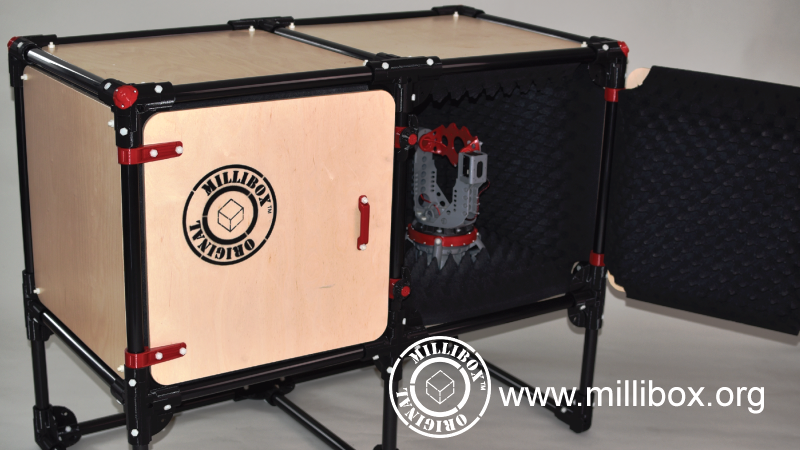 A bit hit at IMS, Milliwave Silicon Solutions displayed the MilliBox, an anechoic chamber for testing mmWave antennas and systems, sized to sit on a lab bench. Three chamber sizes are available to support 80, 140 and 200 cm far-field distances. Milliwave has developed a companion family of 3D gimbals to aid mounting and testing devices in the MilliBox. Controlled over USB with Python scripts, the gimbals enable radiation pattern and beam forming measurements, offering several load capacities and rotational velocities.
A bit hit at IMS, Milliwave Silicon Solutions displayed the MilliBox, an anechoic chamber for testing mmWave antennas and systems, sized to sit on a lab bench. Three chamber sizes are available to support 80, 140 and 200 cm far-field distances. Milliwave has developed a companion family of 3D gimbals to aid mounting and testing devices in the MilliBox. Controlled over USB with Python scripts, the gimbals enable radiation pattern and beam forming measurements, offering several load capacities and rotational velocities.
Mitron has developed 2-6 GHz and 24-40 GHz phase & amplitude controlled modules that have the 50 dB attenuation and 360 degree dynamic range, 0.1 dB and 1 degree attenuation and phase adjusting steps, and maximum 0.2 dB and 2 degree absolute attenuation and phase set-up accuracy at any combination of attenuation and phase. Also, the modules have maximum 0.2 dB and 5 degree amplitude and phase error over the 500 MHz instantaneous bandwidth at any frequency over the entire band. Potential applications include wideband 5G test systems like OTA testing, multi-channel signal route simulation, beam forming, wideband phase array realization and test, multi-channel vector signal sources, as well as high power. As an example, Mitron showed a 2-6 GHz 4 channel arbitrary amplitude and phase signal (OTA) combining emulator. The tested result on the network analyzer showed the combined power value of 4 separate phase and amplitude variable signals with error less than 1.6% compared with theoretical calculation. The other important advantage is there is no external calibration needed.
A new name at IMS this year, MixComm is a fabless silicon RFIC start-up founded in 2017 to commercialize the research of Harish Krishnaswamy’s CoSMIC lab at Columbia University. At IMS, MixComm introduced a patented mmWave power amplifier technology, offering increased output power and efficiency, as well as showing its first-generation phased array RFICs. In addition to Krishnaswamy, co-founder and VP of engineering Frank Lane, VP of technology Arun Natarajan and CEO Mike Noonen were at the symposium. The founding team has a track record of R&D and commercializing RF silicon at both startups and large semiconductor companies.

